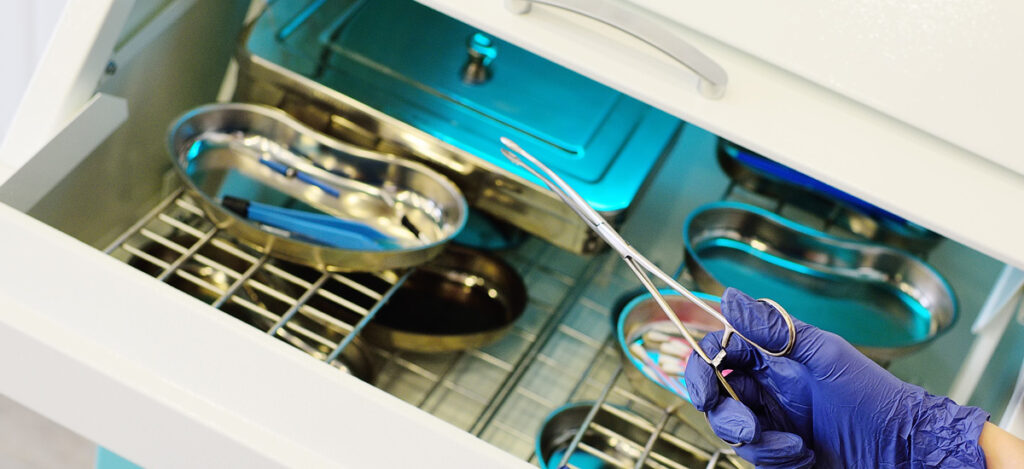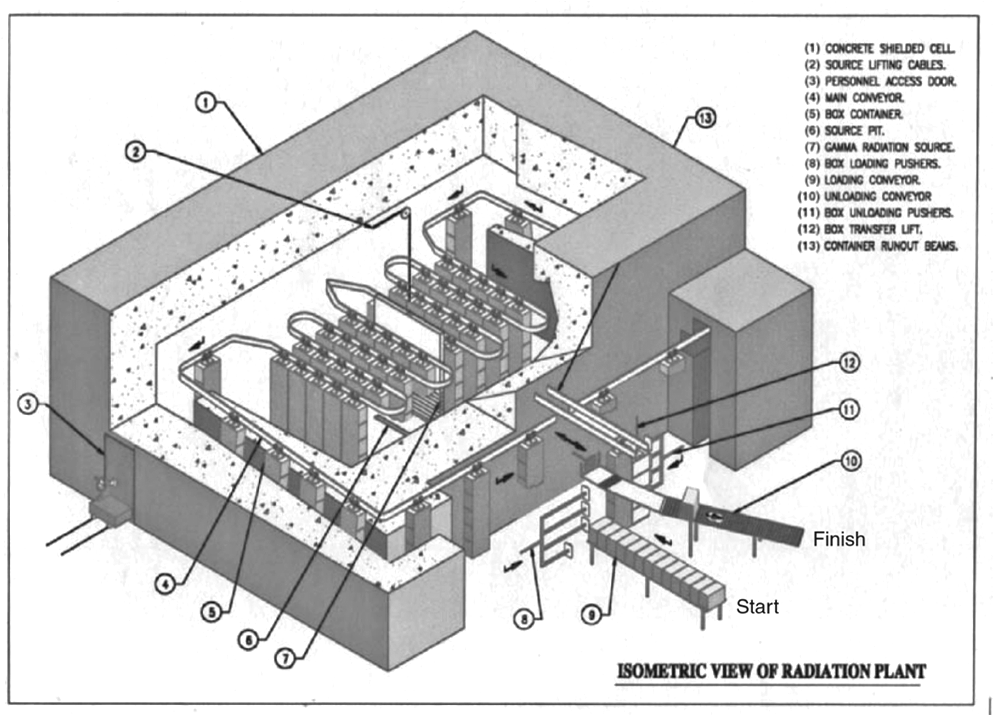Sterilization By Radiation
What is sterilization?
Sterilization is any process that removes, kills, or deactivates all forms of life. Sterilization is related to the term sterile, which means a complete absence of viable microorganisms or microbes that have the potential to reproduce. Thus, sterile products that undergo sterilization are often chemically or heat sterilized after being placed in their final packaging. The chemical or heat sterilization kills any microorganisms inside the products (obtained during manufacturing and packaging). This chemical or heat sterilization process after final product packaging is known as terminal sterilization. The article below covers information on sterilization by radiation, gamma radiation sterilization, radiation sterilization conveyors, and radiation sterilization companies.
What is sterilization by radiation?
Radiation is a non-thermal sterilization method that destroys microorganisms in a product with gamma radiation, beta particles (electron beam), or ultraviolet light. Other than sterile filtration, radiation is the only other sterilization method that doesn’t rely on elevated temperature in order to sterilize. Radiation is an excellent alternative for products that cannot be sterilized with heat or chemicals.
What items can be radiation Sterilized?
Radiation-compatible items are made of the same materials that gaseous methods can sterilize. Standard devices and materials sterilized are plastic materials, heat-labile materials, and powders. Radiation damages the nucleoproteins of microorganisms. Thus, radiation is not recommended for biologics.

How Are Products Sterilized With radiation?
Simply speaking, sterilization is performed by exposing a product to gamma radiation, beta particles, or ultraviolet light. Microwave radiation is sometimes used for empty glass containers but is not considered a primary radiation sterilization method. Electromagnetic gamma radiation is the most effective radiation method due to its deep penetration. Often cobalt 60 high-energy photons are used for gamma radiation. Beta particles, as ionizing radiations, are not electromagnetic and less penetrative. Mechanically accelerated Strontium 90 creates exceptionally high energy levels and the beta particles (electron beams) needed for beta particle radiation. Ultraviolet light can also be used but only as a surface sterilizing method. The energy level of ultraviolet light is too weak to penetrate materials. Gamma sterilization is the most robust sterilization option, but beta particle (e-beam) radiation is also used for product terminal sterilization. Most radiation sterilization companies use gamma sterilization.
Radiation effectiveness is dependent on the radiation dosage and time exposure. A 12-D sterilization overkill approach is used for sterilization validations. The 12-D stands for providing a radiation dose sufficient to produce a 12-log reduction in the D value of the most resistant microbial spore. Note that D value determination for radiation uses dosage rather than time. Typical D values for the most resistant bacterial spore (Bacillus pumulis) to radiation is 1.7 to 2.0 megarad (mRad). Commonly a radiation dosage will be 25 mRad, greater than 12-fold the D value of B. pumulis. During sterilization treatment, dosimeters are placed at strategic locations to monitor radiation doses products receive throughout the sterilization process. When a product goes through a radiation sterilization conveyor (see Figure 1 below), the total radiation dosage is unequally distributed as items under sterilization are conveyed from start to finish. Total radiation percentages are greatest in conveyor areas closest to the source of gamma radiation. The total radiation dose experienced by a product may be 25 mRad. Still, that radiation dosage is distributed throughout the conveyor system to avoid applying an overwhelming or damaging amount of radiation at any given time during sterilization.

Factors that affect radiation sterilization:
- D value of the biological indicator or bioburden level of the item undergoing sterilization
- Radiation strength
- Radiation dose rate
- Conveyor speed
What are the problems with radiation?
There is limited understanding of the molecular transformations in drug molecules and excipients under high-energy gamma radiation exposure. Additionally, there are not many gamma radiation or e-beam radiation sterilization company centers available for bulk sterilizing products compared to other methods, such as ethylene oxide gas. Furthermore, a concern when sterilizing finished products or active pharmaceutical ingredients (APIs) with radiation is the risk of radiolytic byproduct formation (e.g., *OH) that could cause damage to the raw material, API, or product packaging system.
Summary
Overall, radiation is alternative to traditional heat and chemical sterilization methods. Radiation is a cold sterilization method that kills microbes through exposure to gamma, beta particle (e-beam), or ultraviolet radiation. Sterilization validations for radiation use the 12-D overkill method. All in all, ensure you choose a contract testing organization that can provide appropriate sterilization validations for your product needs.
Ethide Labs is a contract testing organization specializing in Sterilization Validations & Sterility Testing. Ethide Labs also offers EO Residual Testing, Microbiology Testing, Cytotoxicity Testing, Bacterial Endotoxin Testing, Bioburden Testing, Package Integrity Testing & Environmental Monitoring services for medical device companies and allied industries. Ethide is an ISO 13485 certified facility.
References
International Organization for Standardization. Sterilization of health care products- Moist heat- Part 1: Requirements for the development, validation, and routine control of a sterilization process for medical devices. Geneva (Switzerland): ISO; 2006. (ISO 17665-1:2006/(R)2016).
Michael J. Akers. Sterile Drug Products Formulation, Packaging, Manufacture, and Quality. Drugs and the Pharmaceutical Sciences. Informa Healthcare. 2010.
United States Pharmacopeial Convention. <1115> Bioburden Control of Non-Sterile Drug Substances and Products. Rockville, MD, USA. 2021. (USPC <1115>).
United States Pharmacopeial Convention. <1116> Microbiological Control & Monitoring of Aseptic Processing Environments. Rockville, MD, USA. 2021. (USPC <1116>).
United States Pharmacopeial Convention. <1211> Sterility Assurance. Rockville, MD, USA. 2021. (USPC <1211>).
Share this in your social networks


